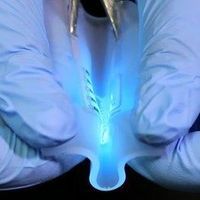Login
Subscribebiomedical engineering

Researchers Develop a CRISPR-Based Therapy That Penetrates Solid Tumors
Jennifer Zieba, PhD | Oct 10, 2022 | 3 min read
By packaging lipid nanoparticles with elements that decrease the fibrous nature of solid tumors, researchers can deliver CRISPR therapies in a more efficient manner.

Ten Years of CRISPR
Sophie Fessl, PhD | Jun 28, 2022 | 7 min read
This month marks ten years since CRISPR-Cas9 was repurposed as a gene editing system, so we’re looking back at what has been accomplished in a decade of CRISPR editing.

A Self-Contained COVID-19 Test with 3-D Printed Parts
Annie Melchor | Aug 11, 2021 | 7 min read
The makers of the CRISPR-based testing platform, called miSHERLOCK, say it could enable people at home or physicians in resource-limited environments to detect SARS-CoV-2—and eventually, other pathogens.

Image of the Day: Bionic Heart
Amy Schleunes | Jan 30, 2020 | 1 min read
A bioengineered heart made of pig and synthetic tissues beats like the real thing.

Image of the Day: Bend and Stretch
Sukanya Charuchandra | Jun 15, 2018 | 1 min read
Circuits made from a novel material are more flexible than ever before.

Small Wonders
Molly Sharlach | Sep 11, 2014 | 2 min read
Sangeeta Bhatia, creator of miniature medical technologies, has won the Lemelson-MIT Prize.

Michael Smith: Biomechanic
Jef Akst | Sep 1, 2013 | 3 min read
Assistant Professor, Biomedical Engineering, Boston University. Age: 37

Organs on Demand
Kate Yandell | Sep 1, 2013 | 10+ min read
3-D printing has made inroads in the clinic, but constructing functional complex organs still faces major hurdles.

Printing Ears
Kate Yandell | Aug 31, 2013 | 1 min read
Cornell University biomedical engineer Lawrence Bonassar 3-D prints ears using “ink” that contains living cells.

Printing Life
Kate Yandell | Aug 31, 2013 | 1 min read
3-D printing allows tissue engineers to fabricate more-complex shapes and to precisely mix biological materials.
